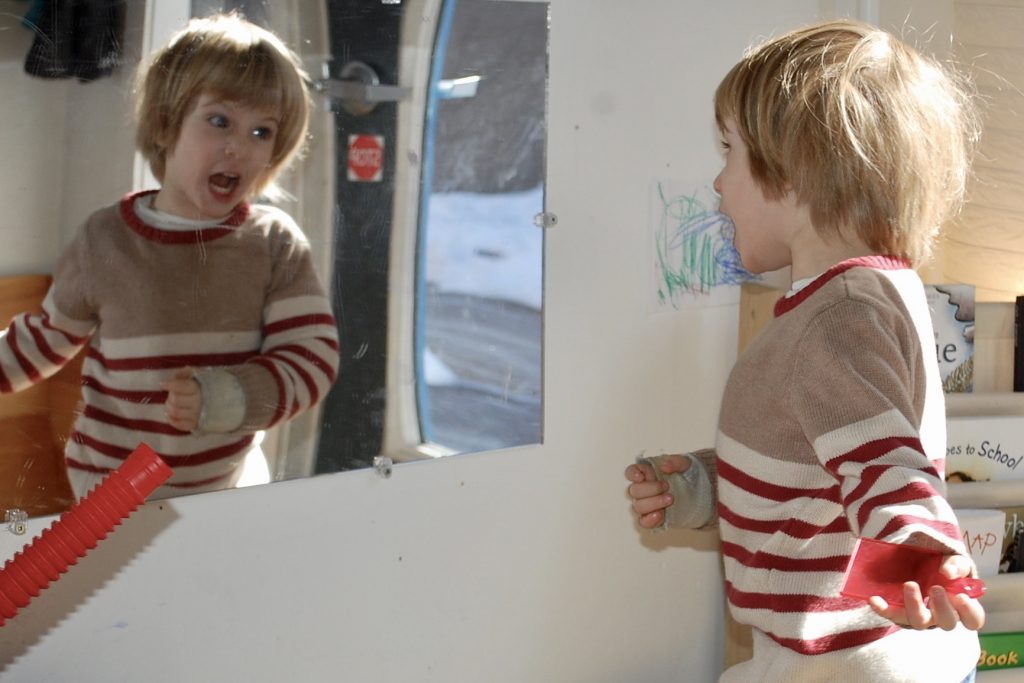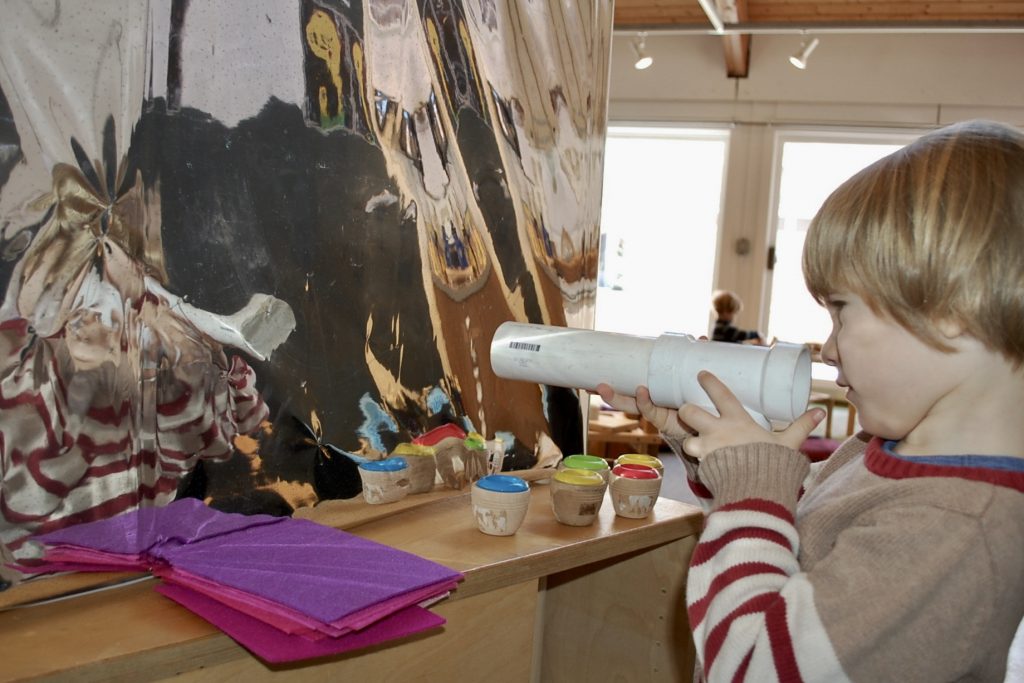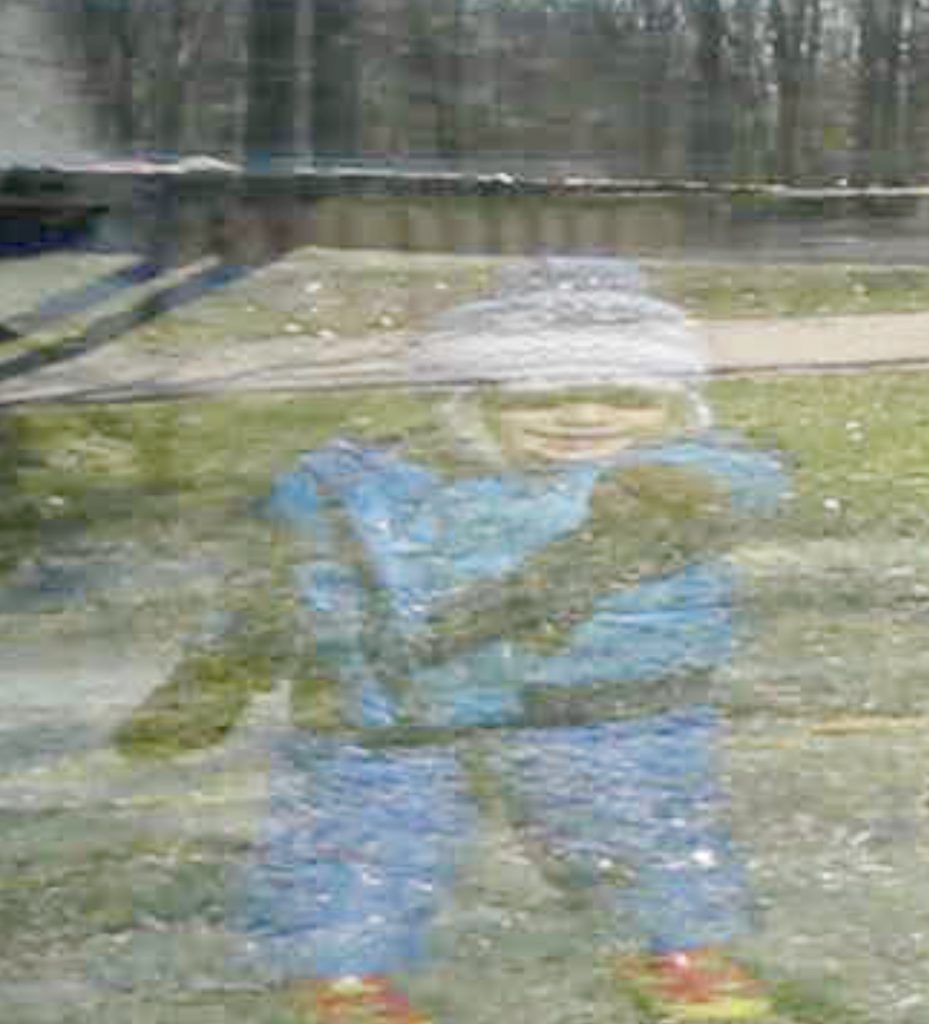How do we form and shape our identities?
For several weeks now, we have noticed Kaya pausing throughout the day to look at his reflection in the mirror. He experiments with different facial expressions and poses, often singing or talking to himself. His words are delivered very quietly, not meant for anyone else to hear. He is thinking. He is wondering. He is trying to figure something out.




As we watched him and listened to Kaya during play, we noticed a reoccurring theme – his play often involved looking for bad guys, “fighting” the bad guys, and eventually pretending to be the bad guys. He would sometimes approach a friend, we’re bad guys, right?
Kaya would often peek through the classroom door, looking out at the playground. When another studio was playing outside, he would announce Bad guys! If the playground was empty, he would inform his friends, The bad guys are not there.
We had previously noted this with other children in Blue – when groups of children from other studios were spotted out at the playground or walking by the window, we heard them say The bad guys! Or if noticing children outside, the bad guys are at the playground.
Initially, labelling other children as “bad guys” seemed to serve two purposes: expressing a wariness around these big unfamiliar children careening around the playground, and, through an “us vs. them” scenario, creating a bond between Blue classmates. For them, it was a useful strategy to instill comfort and camaraderie.
As teachers, we acknowledge/validate the children’s curiosity about weapons and bad guys, but we also help children, who may become stuck in this play, discover other ways to form alliances that are more inclusive and sophisticated. This is the purpose of curriculum, especially in a Reggio-inspired environment; as educator Lillian Katz would say, curriculum “gives us something to talk about.” By enriching the airplane theme, we broadened Kaya’s and others’ options for connecting through play, and the airplane theme has touched much of the class as children share their knowledge, skills, and creative ideas, thus deepening in their comfort and camaraderie.
Kaya’s interest gradually became more internal, as he began striking poses in front of a mirror, eventually including some sort of prop as he experimented with aggressive stances and facial expressions. It was no longer a way to form social connections; he was working out something on a more personal level.




When Kaya explored this theme on the playground, Diane engaged in a dialogue with him, letting him verbalize his thoughts…
Hey everybody, listen up. (inaudible) (turns to Diane) I told them.
What did you say, I didn’t hear you? You said Listen up. And then what did you say?
I said I’m pretend.
Oh, you were telling everybody that you’re pretending?
Well I’m pretending to be a bad guy. I’m pretending to hurt people.
And in the classroom, Diane inquired:
What do you do when you’re pretending to be a bad guy?
Kaya: I shoot and I fight with this. (thin wooden block) I fight with the ones who push me down.
Who pushes you down?
They don’t have names. I don’t know their names but I do know their class.
What class are the bad guys in?
First grade.
How does what we know about the world
shape the way we view ourselves?
At three years old, Kaya is figuring out how to feel safe in his world; a world that sometimes involves first graders that push you down, groups of bigger children running around the playground with you, and many new and exciting, sometimes scary experiences. Listening to Kaya as he clarifies his feelings are an important supplement to our curriculum and materials – although the mirrors and loose parts themselves are clearly integral to Kaya’s emotional development
Kaya’s bad guy play has seemed to subside recently, while he continues enjoying dramatic play with his friends. Now we see him delivering packages, flying an airplane or acting out a favorite story. At the moment, he doesn’t seem to need an object in hand or pause at his reflection as much. On a recent walk out in the sculpture park, though, Kaya happened upon his reflection in the glass. (Crazy Spheroid, Graham)
This time, he greeted himself with a big smile and laughter.


You are a ghost.
He is laughing and looks over to Diane, inviting her to see.
Look!
What are you seeing Kaya?



